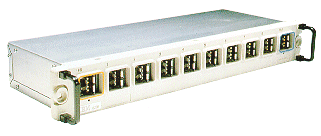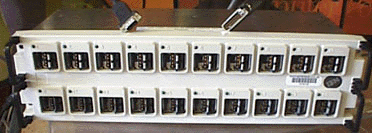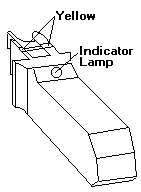8228 MAU
Operational Sounds
8228 Setup Aid
Setup Aid Uses
Test Dongle for DB9
Port
Operational Sounds
Oops! Pulling the plug...
Direct Cable Connection
Oorts
8228 MAU

20 Port MAU?

Image from Symmetry
Computers .
Part Number: 53F5501. Has 20 Token Ring ports. Also has 9-pin and 25-pin
ports in back of unit.
Peter Fires Back-
This is no MAU - it's a LAM ... Lobe Access Module - and
1/4th of a 8230 MAU installation. You need the 8230 base (controller) unit
to use the LAMs. The LAMs come either in 20 x ICS or 20 x RJ-45. They can
be used in mixed configurations.
Building
the 8228 Setup Aid (Off to Peter's site)
Hi Pete !
One thing if you build your own (which I will have to add on my page
soon): there are two "short-circuit" bridges at the front of the "normal"
IBM plug, which connects the two pairs of wires when the plug is pulled
out (automatic internal loopback). These two bridges must be removed on
the "Setup Aid" - or else the LED will light up continously - which is
not the original function :-)
Using the IBM 8228
Setup Aid FRU P/N 6091004 (69X8369)
Use the IBM 8228 Setup Aid after you have installed the 8228 and before
you connect any cables to it. The aid should never be used when the network
is operating !
1. Before you begin make sure no cables are connected to the
8228. If a cable bracket has been installed on the 8228, remove it.
2. Insert the aid into receptacle 1 of the 8228. The yellow stripe
should be aligned with the edge of the receptacle to ensure that the aid
is firmly seated. The light will glow brightly when the aid is initially
inserted and will gradually dim when the aid is firmly seated in the receptacle.
If the light does not glow brightly when you
insert the Setup Aid, remove the srew from the aid and replace the
battery. If the light still does not glow brightly after you have replaced
the battery, try another Setup Aid.
3. Leave the aid in the receptacle for four seconds after the
light has gone out (Ed. Wait to hear
the "click" when the relay is energized). Remove the aid from the receptacle
and insert it into the next receptacle. The yellow stripe should
be aligned with the edge of the receptacle to ensure that the aid is firmly
seated. Go to the next receptacle and repeat this step until you have set
each receptacle, 1 through 8.
4. When you have set receptacle 8, insert the aid into the RI
receptacle for four seconds. The light should glow brightly while the aid
is in the receptacle. If the light does not come on or goes out while the
aid is connected to the receptacle, then the 8228 must be replaced.
Setup Aid Uses
The relays in the 8228 are very sensitive. Most 8228s fail to
operate properly when they have been relocated ... on the bottom of a box
and / or hardly dropped somewhere.
This "8228 setup / testing tool" *must* be used on any
of the 8 data-station ports once before using the MAU, to "prime" test
the relays and re-align them after transportation. I got all my MAU from
customers that claim these were defective ... and all of them did fine
after treatment with the "setup /testing tool". (Guess I have the original
installation instruction somewhere around here ... If I find it I'll make
a PDF from it.)
Test Dongle
for DB9 Port
>I wondered aloud to Tony about a small dongle pass-through on my P70
TR card to 'ring-in' to a mini-MAU if not attached to anything else. Something
in a media filter sized package?
Peter has a flashback and says:
Solder two 470 Ohms resistors diagonally across a Sub-D
9 male plug. 1 - 6 and 5 - 9. That's exactly the layout of the "testing
dongle" used for the TR diags. You could even fake out a server with that,
which otherwise would come up with a "lobe error" when not connected to
a MAU.
Operational Sounds
The 8228 is silent as a grave usually: no PSU, no fan, no harddisk,
no speaker. It "Clicks" once a station inserts in the ring at power up
and starting the adapter. It "Clacks" once a station adapter is shut down.
It click-clack-click-clack-clicks" when Auto-speed adapters try figuring
out what's the ring speed and -finally- enter the ring. It "click-clacks"
multiple if a station tries entering the ring at fixed set a false speed
... which could cause more "clacks" when the other station adapters are
shut due to a "beaconing condition" on the ring (token got lost / adapter
shut down and try to re-insert ) which then may cause some speaker noise
("BIPP !") on the workstation(s) under DOS Lan Manager to notify the user
/ admin of that beaconing condition.
However: all these "8228-noises" are of pretty low level. You hear it
... hmm ... quite well when you are sitting close to the 8228. If one or
more machines are currently running you will have some problems noticing
the clicks and clacks.
Oorts
The advantage of the passive MAU is its simplicity. It
contains a relay for each workstation port, which is opened through a "phantom
voltage" (DC-overlay on the data-wires) and has two special ports "Ring
In (RI)" and "Ring Out (RO)", which are used to daisy-chain multiple MAU
up to 240 user stations.
You don't need a "token server" for either IBM Token Ring
or FDDI. Both of them have protocols built into the network interface
cards that start the token and reconfigure the network when stations are
added or removed.
Neither type goes down when a station is disconnected.
The MAU closes the circuit when it detects loss of connection, unless of
course there's something wrong with the MAU. When that happens the
network cards reconfigure the ring in a few milliseconds and you never
notice that it was down briefly.
With IBM Token Ring, if the network is large enough to
require two MAUs, then if one of the connections from MAU to MAU is broken
the MAUs can reconfigure to run on the remaining cable (MAUs are always
connected to each other with two cables).
With FDDI, the ring can be configured as two rings with
separate tokens, one going around the ring in one direction and the other
in the other. If there is a break anywhere, the ring can reconfigure
and keep running.
To connect Ethernet and Token Ring you need a router--the
router extracts data from Token Ring frames and reencapsulates it into
Ethernet frames. The type of network that can connect to Token Ring
without a router is 100VG, which is designed for the purpose.
Direct Cable Connection?
Unlike connecting two BNC netcards, you can't connect
two TR cards together without a hub (apocryphal tales of a magic cable
and software are unfortunately just that AT THIS TIME). The main
problem is two-fold: 1.) the adapter detects the opening of the ring-insertion
relay and 2.) on the "open adapter command" the communication (insertation)
into the ring must be finished within a certain period of time.
A direct cable connection does not supply the required
change of current flow in the DC-phantom voltage line and to manage simultanously
starting the ring communication on two different PCs *within* the time-limit
is more than unlikely.
Tales of Direct Connection
From Terry King
Peter, back when I was at IBM in Vermont there was some
internal software you could use to make two token-ring cards talk to each
other without a MAU. Somebody must have done this outside IBM???
Peter's Response-
As I wrote earlier in this relation (but not in this thread): there
were rumours about such a tool - and corresponding to a team-mate "We had
that back in 1990 or so ... required a particular cable with 2 resistors
..." but disk and cable have (of course !) gone.
Funny fact: we once had this software in the company (back
in 1990 or so). Someone brought it there and we had a "magic cable" with
a little black box in the middle, which might have contained some resistors
and condensors - but no relay.
On demand I got told that it works this way:
- connect the two computer with that "magical" cable
- start computer #1 ... will come up and "start the ring"
- start computer #2 ... will complain about not being able to insert
in the ring
- start the "magical" software, which will *force* the TR-adapter to
open and insert in the ring
The normal opening requires to receive the "relay opened"
sense signal (change of current flow in the two wires for the +5V phantom
voltage when the relay opens), then trying to read the passing token (if
ring-speed matches ! - or Autosense the ring speed before), then open the
adapter and copy the token informations and pass the token to the next
station (or copy the data from it ..). This procedure must have finished
within a "time-out" limit. If the opening / inserting fails an error-code
is displayed.
The problem is to detect the "ring opened" flow-change
with the MAU missing ... while this cannot be detected the follow-up inserting
will not be started. The software only opens the adapter without waiting
for the "ring opened" signal.
I'm still trying to get more informations about that.
In case I find something ... I will tell.
Oops! Pulling the plug...
Hi Greg !
>Peter, if you have a smart MAU you are probably right but we have
crashed a lot of grocery stores by pulling the wrong plug using an 8228!
I always told my techs to never pull the PC end before they pulled the
"IBM plug" and we stayed out of trouble.
Err ... ahem ... My home-network bases on an 8228 ... and
occasionally I ripped out the Sub-D plug at the adaptercard of a running
machine. The station relay in the 8228 makes "clack" (closing - opposed
to the "click" it switches on) - and nothing else happened. I was just
backing up another machine over the net to a tape on a third active machine
... the machine I disrupted from the net however spit out a network error
(logically). The rest of the net stayed stable.
You might come into troubled water if you only yank out
the Sub-D *partially* and the +5V phantom voltage is still present - which
keeps the station relay up ... in this case the transmitter / receiver
lines might be interrupted and the Token gets lost ... and if this machine
accidently was your "active token monitor" (the first station that sets
the inital Token) it might cause the other stations going into idle (that
"tick - tick - tick" under DOS-Lan) or cause a beakoning condition
while other active ring monitors try to substitute the lost Token.
This happens occasionally in my network when I pull the PCMCIA TR-card
from my Laptop in an absent-minded state before powering the machine down....
:-)
Hi !
First of all: Token-Ring is *not* a serial port. It is ... Token-Ring
:-) Second: you need a 'sort of' hub. In IBM technoslovakian this thing
is called "Multistation Access Unit" (MAU) ... and is a bit expensive if
you take an original MAU.
The IBM passive MAU is the 8228 Model 001. It has 10 ports, 8 of them
are for user-stations, 1 is called Ring In, 1 is called Ring Out. These
2 are for cascading mutiple MAU up to 240 stations.
A typical IBM 8228 Multistation
Access Unit (MAU)
IN 1
2 3 4
5 6 7
8 OUT
+----------------------------------------------------------------+
|o +--+ +--+ +--+ +--+ +--+
+--+ +--+ +--+ +--+ +--+ o|
| |[]| |[]| |[]| |[]| |[]|
|[]| |[]| |[]| |[]| |[]| |
|o +--+ +--+ +--+ +--+ +--+
+--+ +--+ +--+ +--+ +--+ o|
+----------------------------------------------------------------+
From
To
another
8 connectors for stations
another
8228
8228
The original 8228 has connectors of IBM Cabling System
(ICS) and use a very unfamiliar plug, which is called 'Hermaphrodite Plug'
and is plug and socket as well. There are however compatible MAU available
from i.e. AMP, which use RJ-45 connectors. The typical IBM Token-Ring cable
has a 9 pin Sub-D plug on the adapters end and an ICS-plug on the MAU end.
The cable can be extended very easy using another cable with ICS-plugs
on both ends. The maximum cable length between MAU and station can be 300
feet at 4MB/s and 150 feet at 16MB/s.
One *can* create an own cable using shielded twisted pair
cables like used on telephone lines, if the length between adapter and
MAU does not exceed 60 feet. (That's what I often did !) - the ICS plugs
are available separately and are very easy to install with only a larger
plier to press
in the self-cutting cable connector. Takes about 2 minutes with some
experience.
An IBM Token-Ring cabling consist out of 2 pairs of wires,
which create a system of 2 'rings' - one main data ring and an additional
backup ring. The topology is a star (the MAU in the center and the stations
connecting with a single cable to it), the logical architecture is of course
a ring. Each station inserts into this ring without disturbing data-traffic
to the other stations over the MAU. Token-Ring is -other than Ethernet-
a collision-free transmission and a failure in a single station or cable
will not course larger segments to crash.
There are 2 different TR-systems out: the 4MB/s and the
16MB/s Token-Ring. If the cards have a round green decal at the rear bracket
with 16/4 printed on it then these are the adapters which support both
speeds. But you will have to decide which speed you use - either 4 or 16.
An adapter supporting only 4MB/s or set to 4MB/s cannot work in a 16MB/s-net
and other way round.
It is very easy to setup a small network under WfW 3.11,
using the drivers coming with WfW on the older standard MCA TR-adapters.
You may have a dedicated server but must not have one neccessarily. If
you share only ressources like disks or printers the Peer-To-Peer services
will do. It will of course work with Win95 as well, but I would not recommend
Win95 for the old Mod. 70s. A coexistance between WfW-3.11 and Win95 stations
is possible. My personal Token-Ring network in my home-office consists
out of an IBM 8228, an 8595 Server running under Win95, 2 Win95 workstations
(Compaq LTE-5380 and IBM 9556-0BA) and 2 WfW-3.11 workstations (PS/VP and
Mod. 80-A31). Copying of data among these machines works fine with no problems
at 16MB/s.
9595 Main
Page
|


